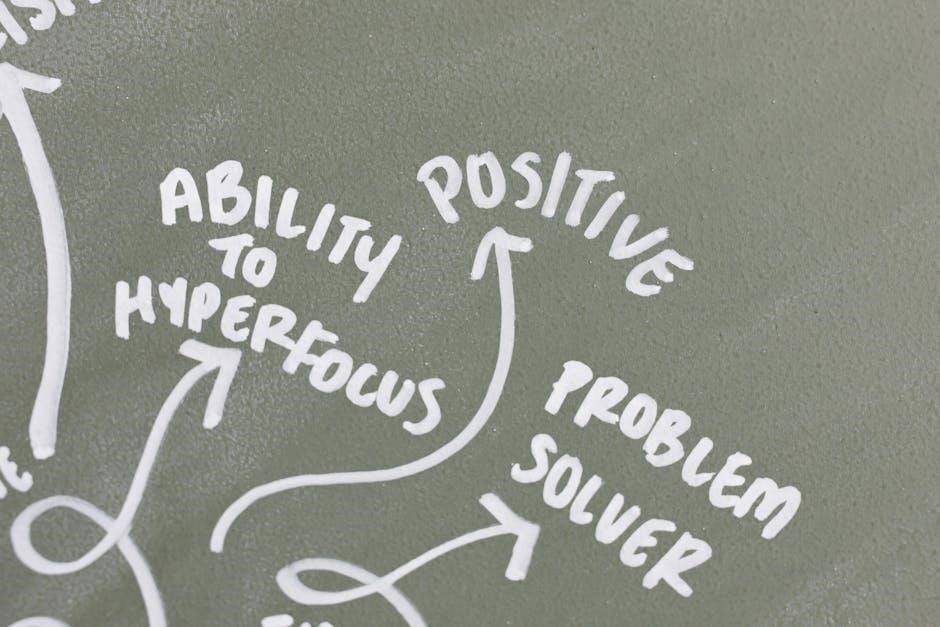Hyperfocus is a mental state of intense concentration, allowing individuals to fully engage in tasks by ignoring distractions. It is often linked to ADHD and enhances productivity.
Definition of Hyperfocus
Hyperfocus is a mental state characterized by intense concentration and deep absorption in a task or activity, often to the exclusion of external stimuli. It is commonly observed in individuals with ADHD and autism, where they can spend hours engrossed in tasks they find fascinating. This state allows for exceptional productivity but can also lead to neglect of other responsibilities. Hyperfocus is distinct from regular focus due to its intensity and the difficulty of shifting attention once engaged. It is often described as “flow” or being “in the zone,” where time seems to pass without notice. This unique cognitive state highlights the brain’s ability to prioritize certain tasks overwhelmingly.
Importance of Understanding Hyperfocus
Understanding hyperfocus is crucial for optimizing productivity and managing conditions like ADHD. It reveals how intense concentration can enhance task completion but may also lead to neglect of other responsibilities. Recognizing hyperfocus helps individuals leverage its benefits while minimizing drawbacks, such as overfocus or burnout. It also aids in developing strategies to transition between tasks and maintain balance in daily life. By grasping the mechanisms of hyperfocus, one can better align their efforts with priorities, improving overall efficiency and well-being. This insight is particularly valuable for those with ADHD, enabling them to harness their unique cognitive strengths effectively.
Hyperfocus and ADHD
Hyperfocus is a common ADHD symptom, allowing intense concentration on interesting tasks for hours, contrasting with distractibility and affecting both children and adults with the condition.
Hyperfocus as a Common ADHD Symptom
Hyperfocus is a common ADHD symptom where individuals intensely concentrate on tasks they find interesting, often for hours, while ignoring external stimuli and losing track of time. It contrasts with distractibility, as those with ADHD can exhibit deep absorption in activities they enjoy, sometimes to the exclusion of other responsibilities. This phenomenon is observed in both children and adults with ADHD, highlighting the brain’s ability to hyperfocus on engaging tasks while struggling with mundane ones. While hyperfocus can enhance productivity, it may also lead to neglect of important tasks, creating challenges in maintaining a balanced daily routine and responsibilities.

The Difference Between Hyperfocus and Distractibility
Hyperfocus and distractibility are two contrasting experiences often linked to ADHD. Hyperfocus refers to an intense, concentrated state of attention on a task or activity, often to the exclusion of other stimuli. In contrast, distractibility involves difficulty maintaining focus and being easily diverted by external or internal distractions. While hyperfocus can enhance productivity, distractibility often hinders it. Both experiences highlight the complexities of attention regulation in ADHD, where the brain may struggle to balance focus and flexibility. Understanding this distinction is crucial for developing strategies to manage attention effectively and improve overall productivity, as discussed in Chris Bailey’s insights on hyperfocus.
How Hyperfocus Affects Daily Life in ADHD

Hyperfocus significantly impacts daily life for individuals with ADHD, often leading to a paradoxical mix of productivity and neglect. While it enables intense concentration on tasks of interest, it can cause individuals to overlook essential responsibilities, relationships, or self-care. Time management becomes challenging, as hours may pass unnoticed during hyperfocused states. This can result in missed deadlines, strained social interactions, or burnout. Additionally, transitioning from a hyperfocused task to less engaging activities can be difficult, leading to frustration or procrastination. Balancing hyperfocus with broader life demands is crucial for maintaining well-being and productivity, as highlighted in Chris Bailey’s discussions on managing attention and focus.

Key Concepts from “Hyperfocus” by Chris Bailey

Chris Bailey explores strategies to enhance focus and productivity by understanding hyperfocus, minimizing distractions, and aligning tasks with personal goals, backed by scientific research and practical advice.
Overview of the Book “Hyperfocus”
In Hyperfocus, Chris Bailey delves into the science of concentration, offering practical strategies to improve focus in a world filled with distractions. Drawing from neuroscience and productivity research, Bailey explains how hyperfocus—the ability to concentrate intensely on a task—can enhance productivity and creativity. He provides actionable techniques, such as eliminating distractions, prioritizing tasks, and creating a conducive work environment. Bailey also explores the balance between focus and rest, emphasizing the importance of mental recovery for sustained performance. The book is a comprehensive guide for anyone seeking to master concentration and achieve their goals in both personal and professional life.
The Four Focusing Questions
In Hyperfocus, Chris Bailey introduces the Four Focusing Questions as a framework to enhance concentration and productivity. These questions help individuals prioritize tasks effectively: (1) What is my goal? clarifies the purpose behind a task. (2) What are the potential distractions? identifies obstacles to focus. (3) How can I eliminate or minimize distractions? provides actionable steps to create a focused environment. (4) How can I stay focused? helps maintain concentration over time. These questions guide readers to align their efforts with priorities, reduce interruptions, and sustain attention, making them a powerful tool for achieving hyperfocus and maximizing productivity.
The Rules of Hyperfocus
In Hyperfocus, Chris Bailey outlines specific rules to help individuals enter and maintain a state of hyperfocus. These rules include prioritizing tasks based on their alignment with long-term goals, eliminating or minimizing multitasking, and creating an environment free from distractions. Bailey also emphasizes the importance of setting clear boundaries with others to protect focus time. Additionally, he advocates for the use of “focus blocks” — dedicated periods of uninterrupted work — and encourages individuals to leverage their natural energy levels to maximize productivity. By adhering to these rules, individuals can better control their attention and achieve hyperfocus, leading to greater efficiency and fulfillment in their work.
Practical Strategies for Inducing Hyperfocus
- Prepare your environment by eliminating distractions.
- Use time-blocking to dedicate focus periods.
- Practice mindfulness to stay present.
- Leverage productivity tools to maintain concentration.
Preparing Your Environment for Hyperfocus
Creating a conducive environment is crucial for inducing hyperfocus. Start by decluttering your workspace to reduce visual distractions; Ensure good lighting and a comfortable temperature to maintain focus. Minimize noise by using noise-canceling headphones or playing ambient music. Consider implementing a “Do Not Disturb” sign or communication boundaries to prevent interruptions. Technology tools like website blockers can also help eliminate digital distractions. A tidy and organized space signals to your brain that it’s time to concentrate. By tailoring your environment to your needs, you create a foundation for deep, uninterrupted focus. This setup helps you enter a state of hyperfocus more easily and maintain it longer.
Techniques to Minimize Distractions
To minimize distractions and foster hyperfocus, employ strategies like the “Pomodoro Technique,” which involves working in 25-minute intervals followed by short breaks. Time blocking can also help by dedicating specific periods to tasks, reducing multitasking. Additionally, the “4 Second Focus” method, where you pause and count four seconds before reacting to distractions, can improve concentration. Prioritize tasks using the “Eisenhower Matrix” to focus on what truly matters. Eliminate multitasking, as it fragments attention. Use tools like website blockers to limit digital distractions. By implementing these techniques, you create a mental and physical environment conducive to deep focus, allowing hyperfocus to emerge naturally and consistently.
Using Time Management Tools for Hyperfocus

Effective time management tools are essential for inducing and maintaining hyperfocus. Utilize calendars to schedule tasks and allocate specific time blocks for deep work. Prioritize tasks using the “Eisenhower Matrix” to differentiate between urgent and important activities. Time tracking apps, such as Toggl or RescueTime, can help monitor productivity and identify distractions. Implement the “Pomodoro Technique” to work in focused 25-minute increments, followed by short breaks. Additionally, to-do lists and task management software like Notion or Todoist can organize tasks, reducing mental clutter. By integrating these tools, you align your environment and habits with hyperfocus, ensuring maximum productivity and mental clarity.

Managing Hyperfocus in Everyday Life
Mastering hyperfocus requires balancing intense concentration with mindfulness, setting clear boundaries, and prioritizing tasks aligned with long-term goals to enhance productivity without burnout.
Setting Boundaries to Avoid Overfocus
Setting boundaries is crucial to prevent hyperfocus from becoming counterproductive. Chris Bailey emphasizes the importance of prioritizing tasks and allocating specific time frames for deep work. By establishing clear limits, individuals can avoid becoming overly engrossed in a single task, which may lead to neglect of other responsibilities or relationships. Implementing time-blocking techniques and scheduling regular breaks helps maintain balance. Additionally, creating mental and physical separation from work during non-work hours fosters mindfulness and reduces the risk of burnout. These strategies ensure hyperfocus is harnessed productively without compromising overall well-being or life quality.
Transitioning Between Tasks Effectively
Chris Bailey highlights the importance of mastering transitions between tasks to maintain productivity and mental clarity. Hyperfocus often leads to deep immersion, making it challenging to switch tasks seamlessly. Bailey suggests using “starting and ending rituals” to signal the brain when a task begins or ends; For example, closing unnecessary tabs or doing a quick stretch can help transition smoothly. Prioritizing tasks beforehand ensures that time spent in hyperfocus aligns with goals. Regularly reviewing progress and adjusting focus prevents overcommitment to less important tasks. These strategies enhance adaptability and reduce mental fatigue, allowing individuals to balance hyperfocus with flexibility in a dynamic environment.
Hyperfocus in the Context of Productivity
Hyperfocus is a powerful tool for enhancing productivity, as it allows individuals to immerse themselves deeply in tasks, leading to exceptional output. Chris Bailey emphasizes that hyperfocus, when directed toward high-impact activities, can significantly boost efficiency and creativity. However, it’s crucial to align hyperfocus with clear priorities to avoid wasting time on less important tasks. Bailey suggests using hyperfocus intentionally by identifying critical tasks and eliminating distractions. This targeted approach ensures that productivity is maximized without sacrificing balance. By mastering hyperfocus, individuals can achieve more in less time, making it a cornerstone of effective time management and goal achievement in both personal and professional contexts.

Hyperfocus and Creativity
Hyperfocus enhances creativity by allowing deep immersion in tasks, fostering innovation and problem-solving. It enables the brain to explore unique connections, generating novel solutions and artistic expression.
How Hyperfocus Enhances Creative Thinking
Hyperfocus creates an immersive state where the mind deeply engages with tasks, fostering creativity. By eliminating distractions, it allows the brain to explore novel connections and ideas. This intense concentration enhances problem-solving, as the mind can freely experiment and innovate. Hyperfocus enables individuals to dive into complex challenges, uncovering patterns and solutions that might otherwise go unnoticed. It nurtures artistic expression and strategic thinking, making it a powerful tool for generating breakthrough ideas. Chris Bailey highlights how this state of focus can unlock creative potential, leading to meaningful and innovative outcomes in various fields, from art to science.

Examples of Hyperfocus in Creative Fields
Hyperfocus is evident in creative fields like painting, writing, and music. Artists often enter a flow state, fully immersing themselves in their craft. Painters like Michelangelo spent hours perfecting details, while writers like J.K. Rowling dedicated long stretches to crafting stories. Musicians similarly lose track of time while composing. Chris Bailey notes that such intense focus allows creatives to produce exceptional work. These examples highlight how hyperfocus enables individuals to push boundaries and deliver innovative results. By concentrating deeply, they unlock their full creative potential, resulting in timeless masterpieces that inspire and influence others across generations.
Hyperfocus in the Digital Age
In the digital age, hyperfocus faces challenges from constant notifications and distractions. Technology both enables and hinders deep focus, requiring intentional strategies to maintain productivity and mental clarity.
The Impact of Technology on Hyperfocus
Technology significantly influences hyperfocus, offering tools to enhance concentration but also introducing distractions. While apps and software can streamline tasks, constant notifications and digital temptations often disrupt deep focus. Chris Bailey highlights how technology can both aid and hinder hyperfocus, emphasizing the need for intentional strategies to manage digital distractions. By leveraging productivity tools and setting boundaries, individuals can harness technology to support hyperfocus rather than undermine it. Balancing tech use is crucial to maintain mental clarity and productivity in a digitally driven world.

Strategies to Maintain Focus in a Digital World
In a world dominated by digital distractions, maintaining focus requires intentional strategies. Chris Bailey suggests minimizing digital interruptions by using app blockers and scheduling specific times for social media and email checks. Prioritizing tasks and eliminating multitasking can enhance concentration. Mindfulness practices, such as regular breaks and breathing exercises, help maintain mental clarity. Creating a distraction-free environment, like turning off notifications or working in quiet spaces, fosters deeper focus. Leveraging technology tools, such as time management apps, can also support hyperfocus. By balancing tech use and implementing these strategies, individuals can stay productive and maintain focus in a digitally demanding world.
Hyperfocus, as explored by Chris Bailey, offers powerful strategies to enhance productivity and mental clarity in a distracting world, empowering individuals to achieve their full potential.
Summarizing the Key Takeaways
Chris Bailey’s work on hyperfocus highlights its transformative potential for productivity and mental clarity. By mastering hyperfocus, individuals can achieve deep concentration, overcoming distractions in a chaotic world. Bailey emphasizes the importance of identifying high-impact tasks, eliminating interruptions, and creating conducive environments for focus. His “Four Focusing Questions” guide prioritization, ensuring efforts align with goals. Additionally, he advocates for time management tools like calendars and task lists to protect focus time. Balancing hyperfocus with flexibility is crucial to avoid overfocus. Ultimately, Bailey’s strategies empower individuals to harness their attention, leading to greater productivity and fulfillment in both personal and professional realms.
Final Thoughts on Mastering Hyperfocus
Mastering hyperfocus, as explored by Chris Bailey, is a powerful tool for enhancing productivity and mental clarity. By aligning focus with priorities and minimizing distractions, individuals can unlock their full potential. While hyperfocus boosts efficiency, it’s crucial to avoid overfocus by setting boundaries and balancing tasks. Bailey’s strategies encourage intentional focus, enabling individuals to achieve more in less time. However, maintaining flexibility is key to adapt to changing priorities. Ultimately, hyperfocus is not just a productivity technique but a mindset that, when practiced consistently, can lead to greater fulfillment and success in both personal and professional life.
